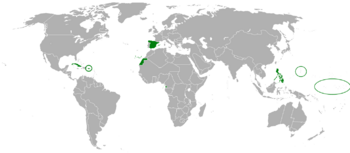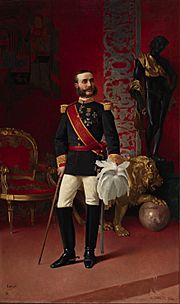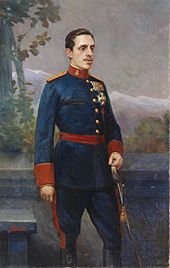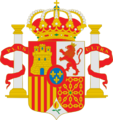Restoration (Spain) facts for kids
Quick facts for kids
Kingdom of Spain
Reino de España (Spanish)
|
|||||||||
|---|---|---|---|---|---|---|---|---|---|
| 1874–1931 | |||||||||
|
Motto: Plus Ultra
"Further Beyond" |
|||||||||

The Kingdom of Spain and its colonies in 1898
|
|||||||||
| Capital | Madrid | ||||||||
| Common languages | Spanish | ||||||||
| Religion | Roman Catholicism (state religion) | ||||||||
| Demonym(s) | Spanish, Spaniard | ||||||||
| Government | Unitary parliamentary constitutional monarchy
|
||||||||
| King | |||||||||
|
• 1874–1885
|
Alfonso XII | ||||||||
|
• 1886–1931
|
Alfonso XIII | ||||||||
| Regent | |||||||||
|
• 1885–1902
|
Maria Christina | ||||||||
| Prime Minister | |||||||||
|
• 1874–1875 (first)
|
Antonio Cánovas | ||||||||
|
• 1931 (last)
|
Juan B. Aznar | ||||||||
| Legislature | Cortes Generales | ||||||||
| Senate | |||||||||
| Congress of Deputies | |||||||||
| History | |||||||||
|
• Pronunciamiento
|
29 December 1874 | ||||||||
| 30 June 1876 | |||||||||
| 25 Apr–12 Aug 1898 | |||||||||
|
• Melilla War
|
1909–1910 | ||||||||
|
• Pact of San Sebastián
|
17 August 1930 | ||||||||
| 14 April 1931 | |||||||||
| Currency | Spanish peseta | ||||||||
|
|||||||||
The Restoration or Bourbon Restoration was a period in Spanish history. It started on December 29, 1874, when General Arsenio Martínez Campos led a military takeover. This event ended the First Spanish Republic and brought the monarchy back to Spain.
Alfonso XII became king. The Restoration period ended on April 14, 1931. This was when the Second Spanish Republic was declared.
Spain had faced many years of political problems and civil wars. The goal of the Restoration was to create a stable political system. This was done through a practice called turnismo. It meant that two main parties, the Liberal and Conservative parties, would take turns governing. This often involved electoral fraud to control election results.
Many groups opposed this system. These included Republicans, socialists, anarchists, and regional nationalists. People from the Basque Country and Catalonia wanted more self-rule. Carlists also opposed the system.
The Restoration period in Spain (1874 to 1931) had many challenges. These included political problems, economic difficulties, and social unrest. Here are some key parts of this time:
- Conservative Politics: This era saw a return to traditional politics. The Bourbon monarchy was re-established. King Alfonso XII brought some stability after years of chaos. However, this stability was often kept by stopping people from speaking out.
- Economic Challenges: Spain struggled with its economy. There was high unemployment and rising prices. A small group of wealthy people controlled most of the country's resources. This led to a lot of social inequality.
- Social Unrest: Many people were unhappy with the social situation. Socialist and anarchist groups grew stronger. They wanted to end the economic and social unfairness. These groups often clashed with the government.
- Regional Tensions: Spain has a long history of different regions. During the Restoration, these tensions grew. Many movements asked for more freedom for regions like Catalonia and the Basque Country.
- The Spanish-American War: In 1898, Spain lost most of its remaining colonies. These included Cuba, Puerto Rico, and the Philippines. This loss greatly hurt Spain's pride. It also had a big impact on the country's economy and politics.
- Cultural Rebirth: Despite the problems, this was also a time of cultural growth in Spain. People became more interested in Spanish art, literature, and music. Many important artists and writers appeared during this period.
Contents
King Alfonso XII and Queen Maria Christina's Rule (1874–1898)
On December 29, 1874, General Arsenio Martínez Campos led a military uprising. This overthrow of the First Spanish Republic brought back the monarchy. Alfonso XII, son of the exiled Queen Isabella II, became the new king.
After this, the Constitution of 1876 was created. It was used throughout the entire Restoration period. This constitution made Spain a constitutional monarchy. It had a two-part parliament called the Cortes Generales. This included an upper house (Senate) and a lower house (Congress of Deputies).
The constitution gave the King power to choose Senators. He could also reject laws if he wished. The King was also made the Commander-in-chief of the army.
These years were a time of economic growth for Spain. Since the end of the Napoleonic Wars in 1815, Spain's economy had fallen behind other European countries. During this period, the country began to modernize on a large scale. Production of goods increased, helped by strong measures to protect Spanish industries.
Two main political parties took turns governing. This controlled process was known as el turno pacífico (the peaceful rotation). The Liberal Party was led by Sagasta. The Conservative Party was led by Canovas del Castillo.
Powerful local figures called caciques were used to rig election results. Because of this, people slowly became unhappy with the system. Important nationalist movements began to form in Catalonia, Galicia, and the Basque Country. Worker unions also started to grow.
Alfonso XII died in November 1885 from an illness. His wife, Maria Christina, was pregnant with their son, Alfonso XIII. Alfonso XIII was born on May 17, 1886, and became king at birth. A regency was formed, led by his mother, Queen Maria Christina.
King Alfonso XIII's Rule and System Challenges (1898–1923)
In 1898, Spain lost its last major colonies overseas. These included Cuba, Guam, Puerto Rico, and the Philippines. This happened during the Spanish–American War.
This quick defeat was seen as a disaster in Spain. It made people lose faith in the government and its ideas. It almost led to a military takeover by General Camilo García de Polavieja. This was the start of the system's decline. It gave power to many different opposing groups across the country.
Alfonso XIII became an adult in May 1902. He was crowned king on May 17, 1902, ending his mother's regency.
Spain began to improve its international standing after the Algeciras Conference in 1906. In 1907, Spain signed a defensive agreement with France and the United Kingdom. This was known as the Pact of Cartagena. It was for protection in case of war against the Triple Alliance.
Spain's economy improved because of its neutrality during the First World War. However, the Spanish flu later killed 200,000 Spaniards, which was about 1% of the population.
Attempts to conquer Morocco failed. The Melilla War caused great unhappiness at home. This led to a revolt in Barcelona, known as the Semana Tragica. The working classes of Barcelona, supported by anarchists, communists, and republicans, protested. They were against what they saw as unfair ways of recruiting soldiers.
The government declared a state of war and sent the army to stop the revolt. This resulted in over a hundred deaths and the execution of Francisco Ferrer. The socialist Unión General de Trabajadores (UGT) and the anarchist Confederación Nacional del Trabajo (CNT) tried to start a general strike across the country. However, it failed because only city workers could be mobilized.
Problems in the Spanish protectorate in Morocco got worse. A native army attacked the Spanish army. They surprised the Spanish forces and, led by the skilled Moroccan chieftain Abd-Al-Krim, almost completely destroyed the Spanish army. They advanced close to Melilla in the Battle of Annual.
This Spanish defeat was due to poor planning. It was blamed on the top military officers. This caused great anger among the military. They felt misunderstood because they had been ordered to advance without enough resources for the difficult territory.
Primo de Rivera's Dictatorship (1923–1930)
The military's unhappiness, fear of anarchist attacks, and the rise of nationalist movements caused a lot of unrest. On September 13, 1923, Miguel Primo de Rivera, the Captain General of Catalonia, led a military takeover. He removed Prime Minister Manuel García Prieto. Primo de Rivera said the problems in Spain were due to the parliamentary system.
Alfonso XIII supported the General and named him Prime Minister. Primo de Rivera then stopped the Constitution and took complete power as a dictator. He created the Unión Patriótica Española, which was the only legal political party. All other parties were banned.
During his rule, he spent a lot of government money on businesses and public services. This caused his government to go bankrupt. He lost the support of the military and faced serious health issues. Opposition to his rule grew so strong that King Alfonso XIII stopped supporting him. The King forced him to resign in January 1930.
The Final Year of the Monarchy (1930–1931)
King Alfonso XIII tried to slowly return to the old system and regain his popularity. He asked General Dámaso Berenguer to form a new government. This plan failed completely. People saw the King as a supporter of the dictatorship. More and more political groups called for Spain to become a republic.
Berenguer resigned, and the King gave the government to Admiral Juan Bautista Aznar. Aznar called for local elections on April 12, 1931. The goal was to please the democrats and republicans. These elections would replace the dictatorship's local governments and slowly bring back the old system.
Even though the monarchists still had some support, the republican and socialist parties won a huge victory. Street protests began, demanding the end of the monarchy. The army announced they would not defend the King. On April 14, he left Spain. The Second Spanish Republic was immediately established. It was led by a temporary government with Niceto Alcalá-Zamora as its head.
Images for kids
Sources
- Barton, Simon. A History of Spain (2009) excerpt and text search
- Beck, Earl Ray. Time of Triumph & Sorrow: Spanish Politics during the Reign of Alfonso XII, 1874–1885 (1979)
- Ben-Ami, Shlomo. "The Dictatorship of Primo de Rivera: A Political Reassessment," Journal of Contemporary History, Jan 1977, Vol. 12 Issue 1, pp 65–84 in JSTOR
- Carr, Raymond, ed. Spain: A History (2001) online
- Esdaile, Charles J. Spain in the Liberal Age: From Constitution to Civil War, 1808–1939 (2000) excerpt and text search
- Hall, Morgan C. "Alfonso XIII and the Failure of the Liberal Monarchy in Spain, 1902–1923" (PhD dissertation, Columbia University; ProQuest Dissertations Publishing, 2003. 3095625)
- Luengo, Jorge, and Pol Dalmau. "Writing Spanish history in the global age: connections and entanglements in the nineteenth century." Journal of global history 13.3 (2018): 425–445. DOI: https://doi.org/10.1017/S1740022818000220
- Payne, Stanley G. A History of Spain and Portugal. Vol. 2 After 1700 (1973) pp 488-512, 578-629. online
- Payne, Stanley G. "Spanish Conservatism 1834–1923," Journal of Contemporary History, Vol. 13, No. 4, (Oct. 1978), pp. 765–789 in JSTOR
- Winston, Colin M. "The Proletarian Carlist Road to Fascism: Sindicalismo Libre," Journal of Contemporary History Vol. 17, No. 4 (Oct., 1982), pp. 557–585 in JSTOR
See also
 In Spanish: Restauración borbónica en España para niños
In Spanish: Restauración borbónica en España para niños











